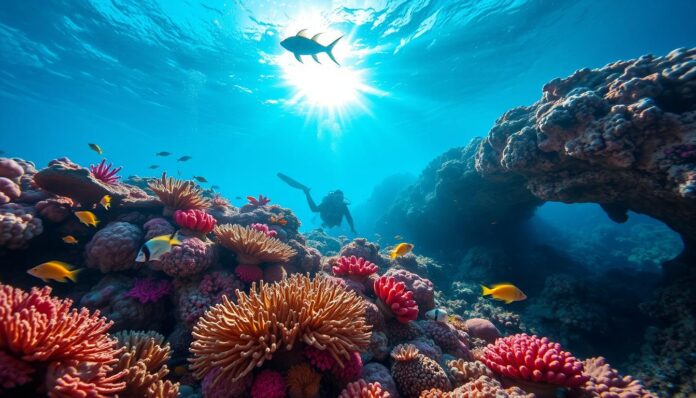| Best Time to Travel | March to June or October to November |
| What to Expect | Warm water, clear visibility, diverse marine life |
| Diving Conditions | Year-round, but best from March to June or October to November |
| Marine Life | Hammerhead sharks, reef sharks, tornados of barracuda, turtles, large schools of fish, dolphins, and more |
Ever wondered about the most untouched underwater paradise? Sudan’s Red Sea might be it. Scuba diving here offers an amazing adventure that few know about.
Red Sea Secrets, a leading diving center in Sudan, reveals a world of underwater wonders. With untouched dive sites and little boat traffic, divers can see marine landscapes untouched by mass tourism.
The area is home to incredible historical treasures, like the SS Umbria wreck from World War II. This 500-foot ship lies at Wingate Reef, carrying 6,000 tons of bombs. It gives divers a unique look into maritime history.
Key Takeaways – Scuba Diving in Sudan
- Sudan offers unique, uncrowded diving experiences in the Red Sea
- Historical wrecks like the SS Umbria provide exceptional underwater exploration
- Dive sites feature pristine marine ecosystems with minimal human interference
- Professional diving centers ensure safe and high-quality experiences
- The region presents opportunities for both beginner and advanced divers
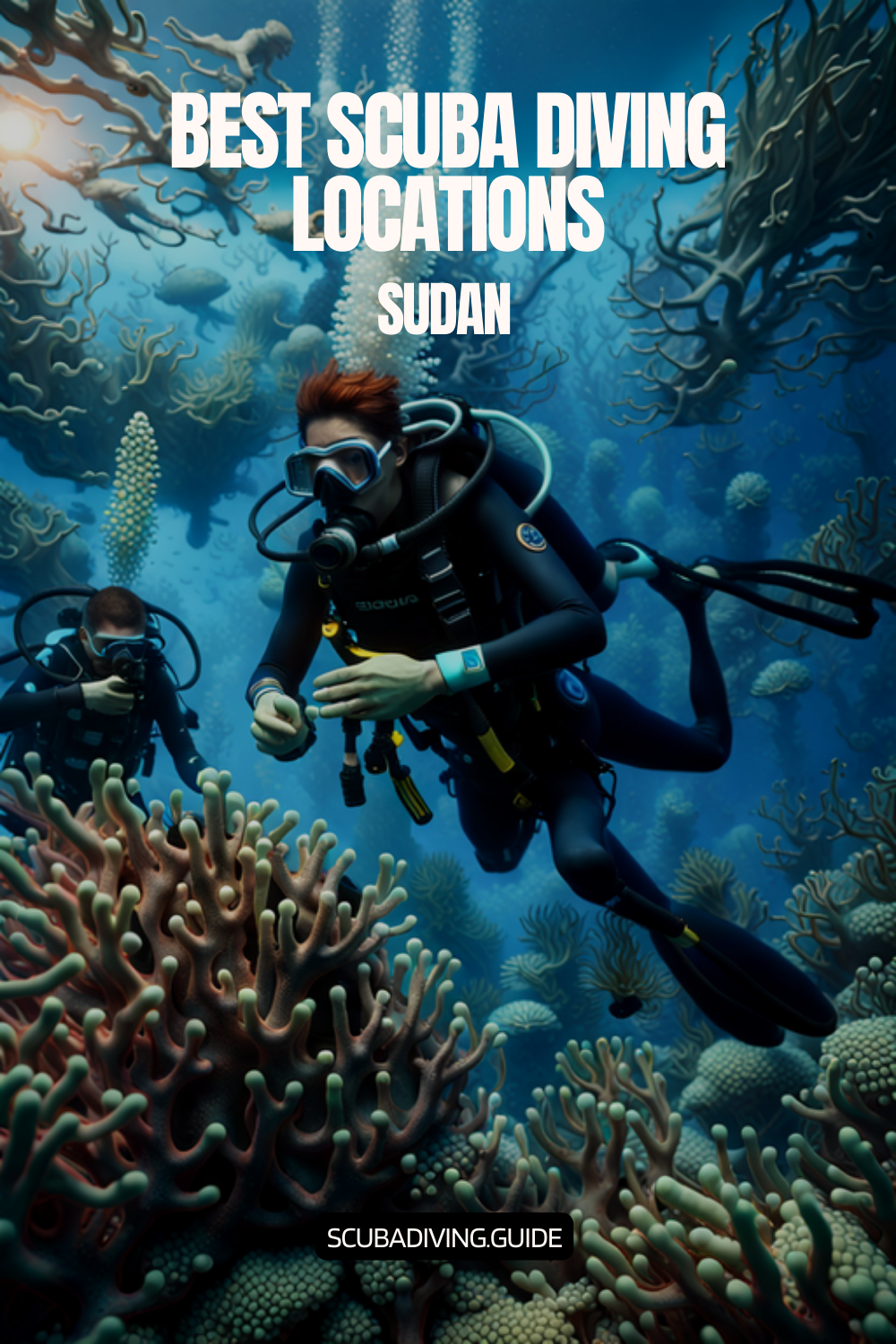
The Allure of Scuba Diving in Sudan
Exploring the underwater world in Sudan is a breathtaking experience. It’s different from the more popular Red Sea diving spots. The waters of Sudan are a unique marine paradise, untouched by mass tourism.
“When you go to the northern Red Sea, there’s going to be 10 boats on a site. With Sudan, you’re probably going to be the only one there.”
Why Sudan Stands Out for Diving
Sudan’s diving sites offer an exclusive underwater adventure. They attract experienced divers looking for pristine marine environments. The region has several compelling advantages:
- Minimal tourist crowds
- Pristine coral reefs
- Exceptional marine biodiversity
- Challenging diving conditions for advanced divers
A Unique Underwater Ecosystem
The Sudanese Red Sea ecosystem is remarkable. It captivates underwater enthusiasts. Divers can expect:
| Marine Feature | Characteristics |
|---|---|
| Coral Reefs | Extensive, untouched formations |
| Marine Life | Diverse species including sharks and rare fish |
| Diving Conditions | Advanced-level challenges |
For marine park expeditions, serious divers need at least 50 logged dives. The best diving weather is between June and August. This makes it perfect for underwater exploration.
Sudan’s diving sites offer an unparalleled experience. They are perfect for those looking for a unique underwater adventure away from crowded spots.
Best Diving Spots in Sudan
The Sudanese Red Sea is a true underwater paradise for divers. It has amazing diving spots with incredible marine life. You can see historic shipwrecks and vibrant coral reefs, making it a unique place to dive.
The Sudanese Red Sea: An Underwater Wonderland
The Red Sea coastline in Sudan is full of diving adventures. It stretches for 853 kilometers, filled with diverse marine life and unique underwater landscapes. Divers from all over the world come to explore these waters.
- Visibility ranges from 10m to 35m
- Water temperatures between 26°C to 29°C
- Depth ranges from 5m to 40m
Sanganeb Atoll: A Marine Sanctuary
Sanganeb Atoll is a stunning marine national park. It offers a chance to dive into pristine coral ecosystems. This UNESCO World Heritage site has dramatic underwater landscapes, colorful coral gardens, and lots of marine life.
“Sanganeb Atoll represents one of the most spectacular diving experiences in the Red Sea” – Marine Exploration Magazine
Shaab Rumi: Cousteau’s Underwater Legacy
Shaab Rumi, explored by Jacques Cousteau, is a unique diving spot. The South Shelf is famous for its marine life. You can see gray reef sharks, barracuda tornadoes, and even the historic Conshelf II underwater habitat.
Divers can visit the legendary Conshelf II. It was built in 1963 and was used in Cousteau’s documentary.
The Red Sea in Sudan offers an unforgettable diving experience. It combines history, marine life, and untouched beauty. It’s a place that few tourists have seen.
Marine Life Diversity
The Red Sea is home to a vibrant underwater world. Divers in Sudan’s coastal waters will find coral reefs and a wide variety of marine life. It’s a breathtaking sight.
Colorful Coral Reefs: Nature’s Underwater Masterpiece
Sudan’s marine landscape is filled with stunning coral reefs. These reefs are key habitats for many marine species. They are like underwater gardens, full of life and beauty.
- Diverse coral species create complex underwater environments
- Nutrient-rich waters support extensive coral growth
- Reef structures provide shelter for countless marine organisms
Fascinating Fish Species
The waters of Sudan are home to a wide range of fish. From small reef dwellers to large pelagic species, divers can see amazing creatures. It’s a true underwater wonderland.
| Fish Species | Size | Unique Characteristics |
|---|---|---|
| Red Sea Clownfish | Up to 5.5 inches | Vibrant coloration, symbiotic relationship with anemones |
| Giant Moray Eel | Up to 10 feet | Impressive length, complex hunting strategies |
| Red Sea Bannerfish | Up to 10 inches | Striking black and white patterns |
Encountering Larger Marine Animals
Sudan’s marine ecosystem is a place of wonder. Divers can see incredible larger marine creatures. It’s a chance to see the grandeur of the underwater world.
“There’s schools of hammerheads and oceanic mantas down there,” says Wayne Brown, CEO of Aggressor Adventures.
- Whale Sharks: Up to 40 feet long, endangered species
- Oceanic Whitetip Sharks: Typically 10 feet in length
- Reef Manta Rays: Wingspan reaching 23 feet
- Dugongs: Growing up to 10 feet long
The marine life in Sudan’s Red Sea is truly remarkable. It’s a world waiting to be explored by those who love the sea. It offers unforgettable experiences for adventurous divers.
Ideal Season for Diving
Planning your Scuba Diving in Sudan means knowing the best times to go. The Red Sea is a top spot for diving all year round. Each season has its own special diving moments.
Dive Packages in Sudan are best during certain times. These times offer the best conditions for exploring underwater. Let’s look at the seasons to help plan your diving trip.
Weather Patterns and Diving Windows
Sudan’s diving seasons fall into clear periods:
- Winter (December-February): Cooler temperatures ranging from 20-25°C
- Spring (March-May): Peak diving season with temperatures 25-35°C
- Summer (June-August): Hot conditions with air temperatures reaching 40-45°C
- Autumn (September-November): Another prime diving window
Water Temperature Insights
Water temperatures greatly affect your dive. Here’s a quick guide:
- Winter: Mid-20s°C, recommended 5-7mm wetsuit
- Spring/Autumn: Mid to high 20s°C, ideal diving conditions
- Summer: Water temperatures can exceed 30°C
Diving Conditions
“September is a prime month for scuba diving, with warm waters and great visibility” – Red Sea Diving Experts
The Red Sea has 360 days a year for diving. Spring and autumn are the best times. They offer:
- More marine life encounters
- Better visibility
- Fewer crowds
- Potential whale shark and hammerhead shark sightings
For the best Scuba Diving in Sudan, plan your Dive Packages in September or October. These months have the best conditions for an unforgettable dive.
Diving Certification and Requirements
Getting ready for diving in Sudan needs careful planning and the right certifications. The Red Sea’s underwater world is unique. It requires specific skills and knowledge for a safe and memorable dive.
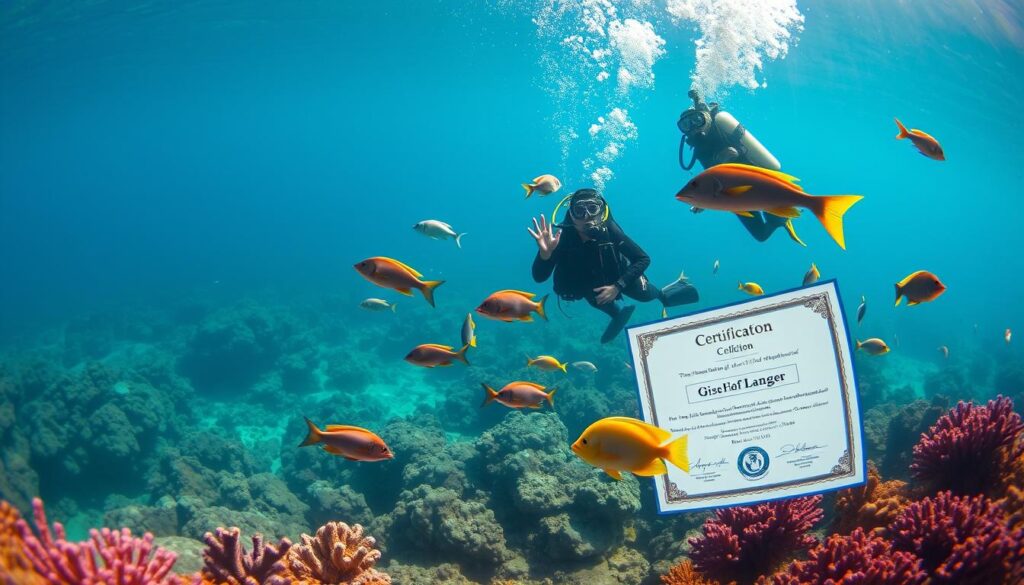
Diving in Sudan is best for experienced divers because of the tough marine conditions. The diving spots usually need advanced certifications to explore safely.
Essential Dive Certification Levels
- PADI Open Water Diver Certification (minimum requirement)
- Advanced Open Water Certification recommended
- Deep Dive Specialty Certification for sites over 30 meters
- Wreck Diving Specialty for exploring historic underwater sites
Equipment Recommendations
Having the right gear is key for safe diving in Sudan’s marine environment. Most diving centers rent out equipment. But, bringing your own gear can make you feel more comfortable and familiar.
| Equipment Category | Recommended Items | Rental Availability |
|---|---|---|
| Personal Gear | Mask, Snorkel, Fins | High |
| Technical Equipment | Dive Computer, Wetsuit | Medium |
| Safety Gear | Dive Knife, Surface Marker Buoy | Low |
“Preparation is the key to an extraordinary underwater experience in Sudan’s Red Sea.” – Professional Diving Instructor
Before you start your diving adventure, check your Dive Certification with local diving centers. Red Sea Secrets, Sudan’s first scuba diving center, offers professional training. They can also check if your certification is up to date.
Additional Safety Considerations
- Get full dive insurance
- Do a medical fitness check
- Check your equipment before diving
- Know the local marine rules
The diving season in Sudan is from January to May. This is the best time to see the amazing marine life. Make sure you plan your certifications and gear preparation for this period.
Popular Dive Centers in Sudan
Scuba diving in Sudan gives adventurers a chance to see unique underwater sights. Several professional dive centers offer great dive packages. These packages let enthusiasts explore the Red Sea’s hidden marine landscapes.
Dive centers in Sudan are in the best spots to see the Red Sea’s amazing underwater scenes. Divers can pick from many professional groups. These groups offer top-notch services and know-how.
Port Sudan Dive Center
Port Sudan Dive Center is in the main sea port. It specializes in diving nearby marine sites. Their dive packages include:
- Comprehensive guided tours
- Professional equipment rental
- Certification courses
- Experienced local guides
Red Sea Diving College
This center is all about advanced training and exploring Sudan’s underwater worlds. They offer:
- Advanced certification programs
- Specialized marine photography workshops
- Wreck diving expeditions
- Customized dive packages
Aqua Sport Sudan
Aqua Sport Sudan offers diving experiences for all levels. They have unique services like:
- Multi-day dive expeditions
- Safety-focused training programs
- Small group diving experiences
- Modern diving equipment
“Sudan’s dive centers offer world-class underwater adventures that remain largely undiscovered by mainstream tourism.” – Marine Exploration Magazine
| Dive Center | Specialization | Best For |
|---|---|---|
| Port Sudan Dive Center | Local Marine Exploration | Beginner to Intermediate Divers |
| Red Sea Diving College | Advanced Training | Professional Divers |
| Aqua Sport Sudan | Comprehensive Experiences | All Skill Levels |
Each dive center in Sudan offers unique chances to explore the Red Sea’s underwater wonders. They do this through carefully made dive packages.
Safety Tips for Scuba Divers
Diving safety is key for a great underwater adventure, like in Scuba Diving in Sudan. Knowing and following important safety rules can turn a risk into a memorable trip.
Pre-Dive Safety Checks
Doing thorough safety checks before diving is vital. Divers should check their gear to make sure it works well:
- Look for cracks or damage on the mask
- Test the regulator to see if it breathes smoothly
- Check the air tank’s pressure and connections
- Make sure the buoyancy compensator (BC) is inflated right
- Check the weight belt and emergency release
Importance of the Buddy System
Having a diving partner is very important. Studies show that diving with a buddy can cut down accidents by up to 70%. The buddy system means you can help each other in emergencies.
“In diving, your partner is your lifeline – trust, communicate, and protect each other.”
| Safety Metric | Recommendation |
|---|---|
| Maximum Dive Depth | 40 meters (130 feet) |
| Pre-Flight Wait Time | 24 hours after diving |
| Medical Screening | Recommended before first dive |
In Sudan, diving safely means knowing the local waters, sticking to depth limits, and talking clearly with your buddy. Keeping safety first makes exploring the Red Sea’s wonders even better.
Dive Courses Available
Sudan’s Red Sea is a great place for divers to learn more. It offers Dive Certification programs for all levels. Whether you’re new or have lots of experience, there’s a dive package for you.
Learning to dive is important. Diving centers in Sudan have courses that meet international standards. They prepare you for amazing underwater adventures.
Beginner Diving Courses
For beginners, there are several courses to start with:
- Discover Scuba Diving: A quick introduction to underwater exploration
- Open Water Diver Certification: Basic skills and theory for new divers
- Introductory safety training with professional instructors
Advanced Diving Certifications
For those with more experience, there are advanced Dive Certification programs:
- Advanced Open Water Diver
- Underwater Navigation Specialties
- Deep Diving Techniques
- Marine Life Identification Courses
“Every dive is an opportunity to learn and explore the magnificent underwater world of Sudan’s Red Sea.”
Dive packages vary from weekend workshops to longer programs. Prices are between $300-$800, based on the course and its length. Dive centers also offer flexible schedules to fit your travel plans.
Eco-Conscious Diving Practices
Protecting the Red Sea’s marine ecosystems is key. Coral reefs are complex and fragile. Divers must handle them with care.
Divers are important in saving marine life. They can do this by following simple rules. These rules help keep the ocean clean.
- Perfect buoyancy control to avoid damaging coral structures
- Maintain a safe distance from marine organisms
- Never touch or remove marine life from its habitat
- Use reef-safe sunscreen to prevent chemical contamination
Preserving Coral Reefs
Sudan’s underwater world has amazing coral reefs. They need our protection. Responsible diving techniques help keep them safe.
“Every dive is an opportunity to be a guardian of marine environments.”
Responsible Marine Interaction
Knowing how marine life behaves is important. By watching without touching, divers can enjoy Sudan’s Red Sea. This way, they help keep the ocean’s balance.
- Use passive observation techniques
- Avoid chasing or feeding marine animals
- Respect underwater wildlife territories
- Participate in local conservation efforts
By following these eco-friendly diving tips, divers help protect Sudan’s beautiful marine life. This way, future generations can also enjoy these wonders.
Travel and Accommodation Options
Planning your Scuba Diving in Sudan adventure needs careful thought. You must understand travel logistics well. Dive packages to this unique spot require strategic planning for a smooth and memorable dive.
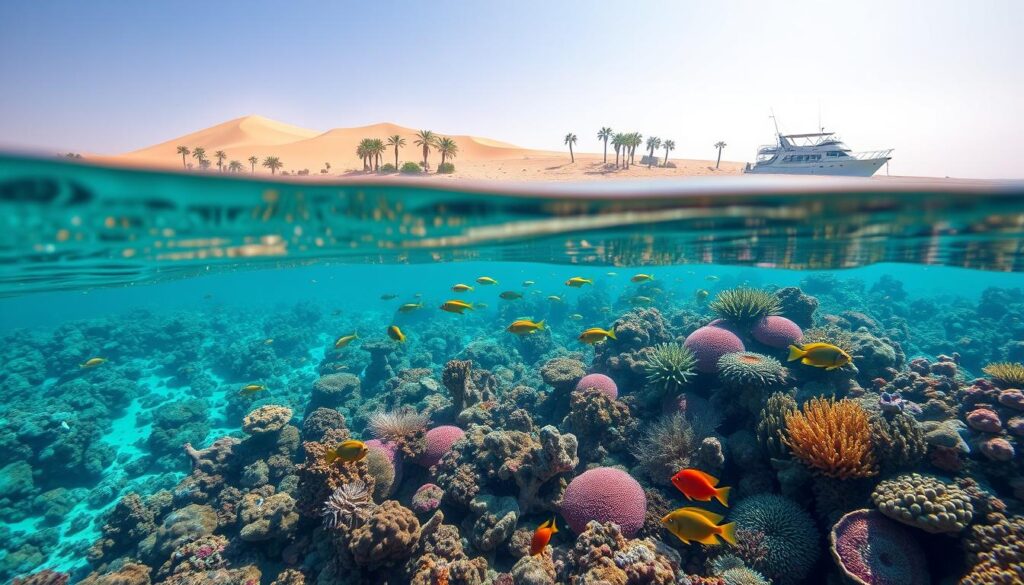
Sudan has many travel routes for diving fans looking for amazing marine experiences. International travelers can reach dive spots through several entry points. This makes exploring the underwater world more accessible.
Flight Connections to Sudan
Liveaboard diving trips in Sudan start from several international airports. This makes it easy for divers from all over to join. Key flight routes include:
- Direct flights from Khartoum
- Connections from Cairo, Egypt
- Routes via Dubai, UAE
- Flights from Jeddah, Saudi Arabia
Recommended Accommodation for Divers
Dive packages in Sudan offer two main accommodation choices:
- Liveaboard Boats: Great for full diving experiences
- Port Sudan Hotels: Good for shorter diving trips
“Sudan’s underwater world offers unparalleled diving experiences for adventure seekers.” – Marine Exploration Magazine
Essential Travel Information
| Travel Requirement | Details |
|---|---|
| Visa Duration | Valid only for tour duration |
| Mandatory Vaccination | Yellow Fever |
| Passport Validity | Minimum 6 months from departure |
| Entry Fees | Approximately €400 + $155 per person |
Diving fans should get good travel insurance. Make sure all your documents are up to date before your Scuba Diving in Sudan adventure.
Cultural Insights for Divers
Scuba diving in Sudan is more than just exploring the sea. It’s about connecting with the local culture. This makes your dive more than just a trip; it’s a chance to share and learn.
Sudan’s culture is rich and diverse. It adds depth to your diving experience. Being respectful and aware of the culture helps you connect with the locals.
Understanding Sudanese Culture
Sudanese people are known for their hospitality and respect. Divers will find themselves in a world of cultural discovery. It’s not just about the sea; it’s about the people too.
- Dress modestly, even when not diving
- Learn basic Arabic greetings
- Always ask before taking photos
- Know about local religious traditions
Local Customs to Respect
When diving in Sudan, remember these cultural tips:
- Greetings are key: Say “As-salaam-alaikum” to show respect
- Don’t show too much affection in public
- Wear modest clothes on land
- Be patient and curious about local customs
“Respect for local culture transforms a simple diving trip into a profound cultural journey.” – Sudanese Travel Guide
By following these cultural tips, divers can make lasting connections. They’ll experience Sudan’s beauty both above and below the water.
Travel Insurance for Divers
Planning a scuba diving trip in Sudan needs careful planning. One key thing often missed is getting good travel insurance. Having the right insurance is vital for safety, covering unexpected events.
Dive packages are big investments. So, getting insurance is a must for divers. But, regular travel insurance often doesn’t cover diving risks well.
Importance of Coverage
Diving-specific insurance gives more protection than usual travel insurance. It covers important areas like:
- Emergency medical evacuation
- Hyperbaric chamber treatment
- Equipment loss or damage
- Trip cancellation due to medical reasons
Recommended Insurance Providers
There are many trusted providers for dive insurance:
- Divers Alert Network (DAN): Offers full dive accident insurance
- DiveAssure: Provides main coverage with flexible plans
- Arch RoamRight: Includes special features like security evacuation
“Proper insurance is your underwater safety net – protecting your adventure and your finances.”
When picking dive insurance, look at medical coverage, emergency evacuation, and what diving activities it covers. Most policies need to be bought within 24-72 hours of your trip deposit. They also offer yearly renewals.
Getting good dive insurance means you can dive in Sudan’s amazing waters safely and worry-free.
Preparing for Your Dive Trip
Planning a scuba diving trip to Sudan needs careful thought. The Red Sea’s underwater world requires special packing and preparation. Divers going to Sudan for Dive Packages must think about a few key things for a great trip.
Essential Diving Checklist
Getting ready for diving in Sudan is the first step. Here’s a detailed checklist to help you prepare:
- Valid passport (at least 6 months beyond return date)
- Diving certification documents
- Travel insurance with diving coverage
- COVID-19 documentation (PCR certificate or vaccination proof)
- Multiple copies of important documents
Packing Essentials for Diving
When packing for your dive trip, aim for comfort and safety. Think about Sudan’s diving conditions:
| Gear Category | Recommended Items |
|---|---|
| Personal Diving Equipment | Mask, snorkel, fins, dive computer, underwater camera |
| Protective Clothing | Lightweight wetsuit, rash guard, sun protection |
| Temperature Considerations | Water temperatures range from 23°C to 29°C |
Climate and Packing Tips
Sudan’s climate can be tough. Temperatures can reach up to 40 degrees Celsius. So, pack light, breathable clothes. Most dive operators offer tank rental and some gear, but personal gear ensures comfort.
“Preparation is the key to an unforgettable diving experience in Sudan’s remarkable Red Sea waters.”
Scuba diving tip for Sudan: Pack light, moisture-wicking clothes, and bring extra dive-friendly outfits. Check with your Dive Packages provider about gear recommendations and any personal gear restrictions.
Engaging with Local Communities
Scuba diving in Sudan is more than just exploring the sea. It’s a chance to connect with local people and help sustainable tourism grow. The dive sites are not just for seeing marine life but also for cultural exchange.
Traveling in Sudan through community-based tourism changes the way we see travel. Divers can help the local economy and learn about Sudanese culture.
Community Tourism Opportunities
- Participate in local marine conservation projects
- Support small-scale tourism enterprises
- Engage with coastal community workshops
- Learn traditional fishing techniques
Supporting Local Initiatives
The Sudanese Red Sea is full of chances for responsible travelers. By choosing local guides and supporting community tourism, divers can really help.
“Responsible travel is about creating connections, not just consuming experiences.”
| Community Initiative | Impact | Traveler Involvement |
|---|---|---|
| Marine Conservation Program | Protect underwater ecosystems | Volunteer, donate, learn |
| Local Artisan Workshops | Support traditional crafts | Purchase local handicrafts |
| Sustainable Fishing Education | Preserve marine resources | Participate in awareness programs |
Scuba diving in Sudan becomes a journey of cultural discovery when you engage with the community. By supporting local projects, travelers help the area grow and make lasting memories.
Share Your Diving Experience
Exploring the underwater world in Sudan is a thrilling adventure. Divers can capture and share their marine experiences. Waterproof cameras with high-resolution are key to capturing the beauty of marine landscapes.
Platforms like Instagram, Facebook, and diving forums are great for sharing your dives. Remember to share responsibly to protect marine life. Share your amazing encounters with hammerhead sharks and the beauty of Shaab Rumi reef.
Documenting Your Adventures
Underwater photography in Sudan requires special skills. Wide-angle lenses are essential for capturing the vast underwater scenes. Use natural light and slow movements to capture marine life without harming coral.
Your photos can inspire others to dive in Sudan. They show the beauty of the underwater world.
Online Diving Communities
Join global diving communities to share your experiences. Sites like ScubaBoard and DivePhotoGuide are perfect for this. They offer a place to share, get advice, and learn from others who have dived in Sudan.
Your stories can help grow appreciation for the Red Sea’s underwater world. They inspire others to explore its wonders.
Sudan Recommended Scuba Diving Itinerary
When planning your scuba diving trip to Sudan, having a well-structured itinerary can help you make the most of your time and ensure that you experience the best dive sites the country has to offer. Here’s a recommended scuba diving itinerary that highlights some of the must-visit locations along the Sudanese coastline:
Day 1: Arrival in Sudan
Upon your arrival in Sudan, you’ll be greeted by the warm hospitality of the locals and the anticipation of the underwater adventures that lie ahead. Depending on your arrival time, you can spend the day exploring the vibrant capital city of Khartoum or relaxing and acclimatizing to your new surroundings.
Day 2-3: Khartoum to Port Sudan
From Khartoum, make your way to Port Sudan, the gateway to Sudan’s world-class dive sites. Take a domestic flight or enjoy a scenic road trip, soaking in the beautiful landscapes along the way. Once in Port Sudan, settle into your accommodation and familiarize yourself with the diving facilities and amenities.
Day 4-6: Northern Dive Sites
Embark on your first diving adventure at the remarkable dive sites located in the northern part of Sudan’s Red Sea coast. Explore sites such as Sanganeb Atoll and Shaab Rumi, where you’ll encounter vibrant coral gardens, underwater ruins, and a variety of marine species. Marvel at the abundance of sharks, rays, and colorful fish that call these reefs home.
Day 7-9: Central Dive Sites
Continue your journey southward to explore the central dive sites of Sudan. Dive in renowned locations like Angarosh Reef, Merlo Reef, and Wingate Reef. Immerse yourself in the stunning underwater topography, including drop-offs, caves, and overhangs, while encountering pelagic species such as hammerhead sharks and manta rays.
Day 10-12: Southern Dive Sites
Head further south to discover the captivating dive sites in the southern region of Sudan. Explore sites like Shaab Ambar, Shaab Suedi, and Sanganeb Lighthouse Reef. Dive along vibrant coral walls, encounter dolphins, turtles, and an array of colorful reef fish. Take in the breathtaking beauty of these pristine and untouched underwater ecosystems.
Day 13-14: Return to Port Sudan and Departure
Conclude your scuba diving adventure by returning to Port Sudan, where you can reminisce about the incredible dive experiences and bid farewell to the Red Sea’s enchanting waters. Take the opportunity to explore Port Sudan’s local markets, enjoy authentic Sudanese cuisine, and immerse yourself in the rich cultural heritage of the region. Finally, depart with cherished memories and a desire to return for more diving adventures in Sudan.
It’s important to note that the suggested itinerary can be customized based on your preferences, dive experience, and the duration of your trip. Factors such as weather conditions and dive site accessibility may also influence the sequence and selection of dive sites.
When planning your scuba diving itinerary, it’s advisable to consult with local dive centers and professionals who have extensive knowledge of the region. They can provide valuable insights, recommendations, and help you make the most suitable choices based on the prevailing conditions and your individual preferences.
Sudan’s diverse and captivating dive sites offer a wealth of underwater exploration opportunities. Following a well-designed itinerary ensures that you experience the best of Sudan’s underwater wonders, creating memories that will last a lifetime.
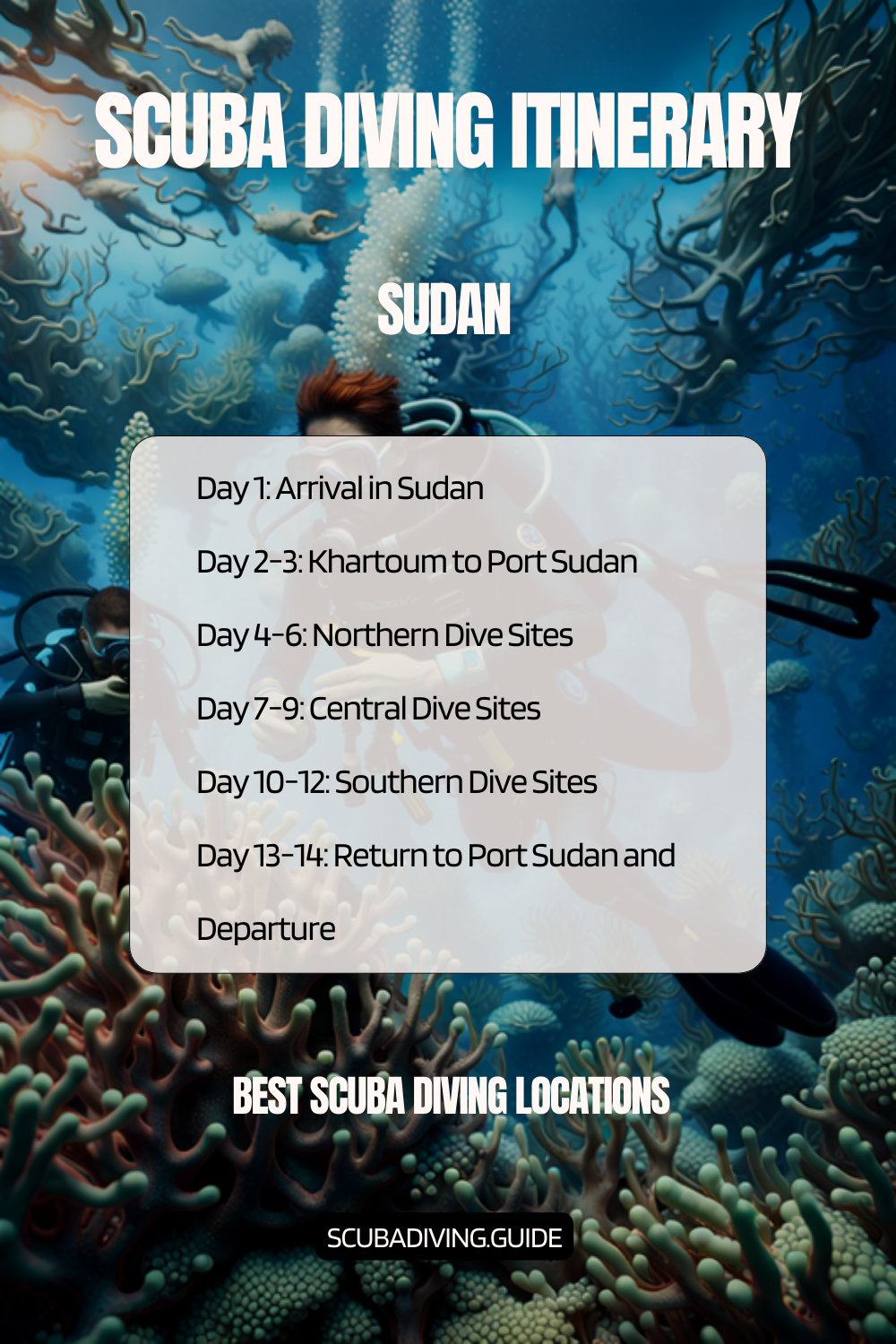
Other Countries to Consider
- Egypt
FAQ – Scuba Diving in Sudan
Is Sudan a safe destination for scuba diving?
Sudan is a great place for diving, thanks to the Red Sea. Always check travel advisories first. But, diving sites are usually safe, with dive centers focusing on safety and support.
What certification level do I need to dive in Sudan?
You’ll need an Open Water Certification or Advanced Open Water to dive in Sudan. Some sites require more advanced skills. Dive centers can check your skills for each location.
When is the best time to go scuba diving in Sudan?
The best time to dive in Sudan is from March to November. June to September is the peak. The water is warm, and the seas are calm, making it perfect for diving.
What marine life can I expect to see while diving in Sudan?
Sudan’s Red Sea is full of marine life. You’ll see colorful reefs, hammerhead sharks, manta rays, and many fish species. It’s a chance to see both small and large sea creatures.
Are there any specific equipment recommendations for diving in Sudan?
You’ll need a 3mm wetsuit, dive computer, and safety sausage. Don’t forget an underwater camera and reef-safe sunscreen. Renting gear is common, but bringing your own is more comfortable.
How do I get to Sudan for a diving trip?
Fly into Port Sudan International Airport, often through Dubai or Cairo. Dive operators usually offer packages with airport transfers and places to stay.
What are the visa requirements for diving in Sudan?
You’ll need a visa to enter Sudan. Get it in advance from your embassy or consulate. Some dive operators can help with this.
Is travel insurance necessary for a diving trip to Sudan?
Yes, it’s essential. You need insurance for medical emergencies and evacuation. Dive centers may ask for proof before you dive.
What are the top diving sites in Sudan?
Top sites include Sanganeb Atoll, Shaab Rumi, and Red Sea marine parks. They offer stunning underwater views, from coral gardens to shipwrecks.
How can I practice responsible diving in Sudan?
Dive responsibly by staying buoyant and not touching marine life. Use reef-safe sunscreen and follow local conservation rules. Many dive centers promote sustainable diving.
